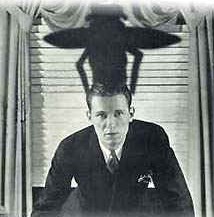
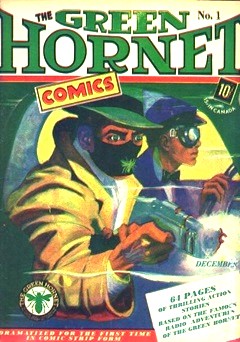 The Green Hornet (1936-1952) aired “Income from Immigrants” on March 6, 1940 as its 424th episode out of over 1,000. The Green Hornet was created specifically for radio by producer George Trendle and director James Jewell. The first episode aired January 31, 1936. The series proved so popular its run lasted sixteen years, with its final episode airing in late 1952. The 1940s saw two movie serials featuring the Green Hornet and his staunch ally Kato (The Green Hornet–1940, and The Green Hornet Strikes Again!–1941), which only served to heighten the popularity of the radio show. Several attempts at Green Hornet movies have been made (most recently in 2011) but none have proved as successful as the radio show (this includes the short-lived Green Hornet TV show from the 1970s, which nevertheless catapulted Bruce Lee to stardom in his role as Kato). Over its long radio run four actors were the voice of Britt Reid/the Green Hornet. From the show’s inception in 1936 through 1943 Al Hodge (1912-1979) was the voice of the Hornet (photo top right). In later years he would take on the role of Captain Video (1950-55, photo middle right) for the early television show Captain Video and His Video Rangers (1949-55), the first show of its kind on American television.
The Green Hornet (1936-1952) aired “Income from Immigrants” on March 6, 1940 as its 424th episode out of over 1,000. The Green Hornet was created specifically for radio by producer George Trendle and director James Jewell. The first episode aired January 31, 1936. The series proved so popular its run lasted sixteen years, with its final episode airing in late 1952. The 1940s saw two movie serials featuring the Green Hornet and his staunch ally Kato (The Green Hornet–1940, and The Green Hornet Strikes Again!–1941), which only served to heighten the popularity of the radio show. Several attempts at Green Hornet movies have been made (most recently in 2011) but none have proved as successful as the radio show (this includes the short-lived Green Hornet TV show from the 1970s, which nevertheless catapulted Bruce Lee to stardom in his role as Kato). Over its long radio run four actors were the voice of Britt Reid/the Green Hornet. From the show’s inception in 1936 through 1943 Al Hodge (1912-1979) was the voice of the Hornet (photo top right). In later years he would take on the role of Captain Video (1950-55, photo middle right) for the early television show Captain Video and His Video Rangers (1949-55), the first show of its kind on American television.
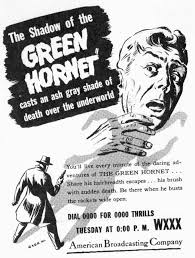
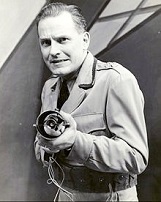 The Green Hornet’s real identity is Britt Reid, publisher of the Daily Sentinel. During a visit to the Far East, Reid saved Kato’s life. Kato now links his fortune to that of Reid as a faithful companion, driver of the Black Beauty (forerunner of the Batmobile), and all-around aide-de-camp. (Cover top left from The Green Hornet #1, December 1940.)
The Green Hornet’s real identity is Britt Reid, publisher of the Daily Sentinel. During a visit to the Far East, Reid saved Kato’s life. Kato now links his fortune to that of Reid as a faithful companion, driver of the Black Beauty (forerunner of the Batmobile), and all-around aide-de-camp. (Cover top left from The Green Hornet #1, December 1940.)
In the 1930s America was rife with criminal organizations, and not only they, but the common criminal element led to many a radio show featuring crime fighters of various stripes. Of those shows featuring crime busters with secret identities, or a special ability or power, or who employed scientific or advanced technology to thwart criminals, perhaps the most popular trio was Dick Tracy (1934-48), The Green Hornet (1936-52), and The Shadow (1937-54). To place the popularity of these “special” crime fighter shows (as opposed to straight detective or police programs, of which there were many) in some sort of perspective, the Great Depression lasted from 1929-39. During this difficult time the underworld took advantage of a ruined economy in any way it could, including bootlegging illegal alcohol during the era of Prohibition (1920-33). While this was but one enterprise crime families adopted, their schemes and violence were felt in many areas of public life. Al Capone was probably the most well known crime family boss of the time, but by the time The Green Hornet program hit the airwaves Capone was himself out of the picture, having been sent to a Florida prison in 1931, where he would die eleven years later. But crime and crime families continued without Al Capone. Scams, cons, local crime gangs, and any number of rackets bent on cheating the public or enriching one’s own pockets abounded (as they do today).
“Income from Immigrants” is another tale pointing the spotlight on the problems inherent in immigration into the United States and the dangers it presents not only to those attempting to enter the United States illegally (as was the case with a couple of previous stories dealing with immigration along our southern border), but an unknown danger as well for those led to believe that with the proper “assistance” they were entering the United States legally, and had begun to live their lives as hardworking, respectable citizens to be. Listen now to this story of immigrants betrayed by an unscrupulous official and his selfish scheme to take advantage of trusting people from another country, as the Green Hornet must track down and expose those who sought to enhance their coffers with “Income from Immigrants.”
Play Time: 27:43
{Airing on a Wednesday in early March of 1940 at 5:30 in the evening meant the neighborhood gang would have to wait until the next afternoon after school to meet up at the nearby newsstand to once again peruse the colorful covers of their favorite genre magazines. Astonishing Stories (1940-43) while lasting only 16 irregularly published issues, nevertheless managed to attract some popular authors who would go on to stellar careers. Among them were Isaac Asimov, L. Sprague de Camp, Manly Wade Wellman, Alfred Bester, and James MacCreigh more than once (MacCreigh being one of the pseudonyms of Frederik Pohl). Astonishing Stories was a bi-monthly in 1940. Astounding Science-Fiction (1930-present, now Analog) was now firmly in the editorial hands of its relatively new editor, John W. Campbell, Jr. Campbell gave the magazine (and most of magazine SF from 1938 forward) a direction, one that would prove a major influence on the field for decades, making it for most of those decades the undisputed leader in the SF magazine field. Astounding SF was a monthly in 1940. Captain Future was the creation of Mort Weisinger and Leo Margulies, and was written almost exclusively by one of the grand masters of galaxy smashing space opera, Edmond Hamilton. Weisinger would go on to be a major force in DC Comics, where Hamilton would trade his time as an early SF author to write many a popular story featuring DC superheroes, the likes of whom were Superman, Batman, and Batwoman among others, and was instrumental in the creation in DC’s Legion of Superheroes. Hamilton would write stories for a number of DC’s superhero line even as late as the early ’60s, a few among them being World’s Finest Comics, Adventure Comics, and Detective Comics. Captain Future (1940-44) was a dependable quarterly throughout its four and a half year press run and kids loved it.}
[Left: Astonishing Stories, 4/40 – Center: Astounding SF, 3/40 – Right: Captain Future, Spring/40]
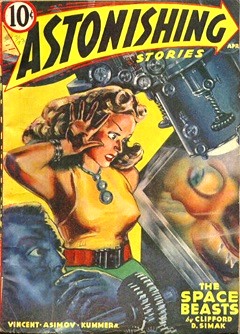
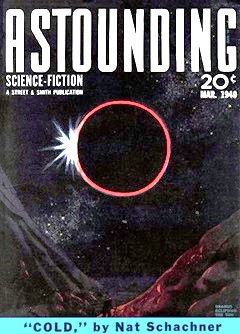
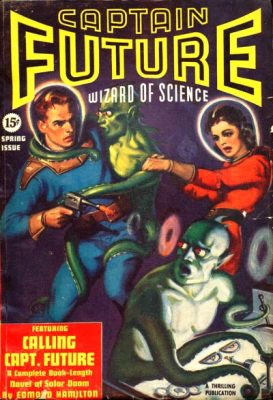
To view the entire list of weekly Old Time Radio episodes at Tangent Online, click here.